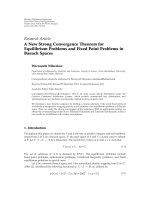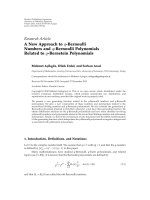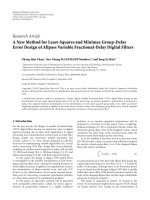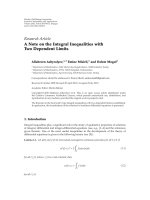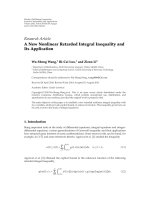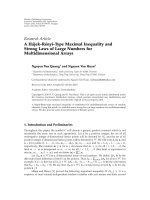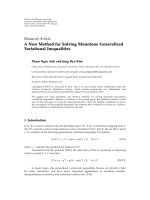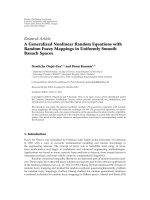Báo cáo hóa học: " Research Article A New Nonlinear Retarded Integral Inequality and Its Application" docx
Bạn đang xem bản rút gọn của tài liệu. Xem và tải ngay bản đầy đủ của tài liệu tại đây (484.08 KB, 9 trang )
Hindawi Publishing Corporation
Journal of Inequalities and Applications
Volume 2010, Article ID 462163, 9 pages
doi:10.1155/2010/462163
Research Article
A New Nonlinear Retarded Integral Inequality and
Its Application
Wu-Sheng Wang,
1
Ri-Cai Luo,
1
and Zizun Li
2
1
Department of Mathematics, Hechi University, Guangxi, Yizhou 546300, China
2
School of Mathematics and Computing Science, Guilin University of Electronic Technology,
Guilin 541004, China
Correspondence should be addressed to Wu-Sheng Wang,
Received 28 April 2010; Revised 9 July 2010; Accepted 15 August 2010
Academic Editor: L
´
aszl
´
o Losonczi
Copyright q 2010 Wu-Sheng Wang et al. This is an open access article distributed under the
Creative Commons Attribution License, which permits unrestricted use, distribution, and
reproduction in any medium, provided the original work is properly cited.
The main objective of this paper is to establish a new retarded nonlinear integral inequality with
two variables, which provide explicit bound on unknown function. This inequality given here can
be used as tool in the study of integral equations.
1. Introduction
Being important tools in the study of differential equations, integral equations and integro-
differential equations, various generalizations of Gronwall inequality and their applications
have attracted great interests of many mathematicians. Some recent works can be found, for
example, in 1–7 and some references therein. Agarwal et al. 1 studied the inequality
u
t
≤ a
t
n
i1
b
i
t
b
i
t
0
g
i
t, s
w
i
u
s
ds, t
0
≤ t <t
1
.
1.1
Agarwal et al. 2 obtained the explicit bound to the unknown function of the following
retarded integral inequality
ϕ
u
t
≤ c
n
i1
α
i
t
α
i
t
0
u
q
s
f
i
s
ϕ
1
u
s
g
i
s
ϕ
2
log
u
s
ds.
1.2
2 Journal of Inequalities and Applications
Cheung 3 investigated the inequality in two variables
u
p
x, y
≤ a
p
p − q
b
1
x
b
1
x
0
c
1
y
c
1
y
0
g
1
s, t
u
q
s, t
dt ds
p
p − q
b
2
x
b
2
x
0
c
2
y
c
2
y
0
g
2
s, t
u
q
s, t
ψ
u
s, t
dt ds.
1.3
Chen et al. 4 discussed the following inequality in two variables
ψ
u
x, y
≤ c
αx
α
x
0
βy
β
y
0
g
s, t
w
u
s, t
dt ds
γx
γ
x
0
δy
δ
y
0
f
s, t
w
u
s, t
ϕ
u
s, t
dt ds.
1.4
Pachpatte 8 obtained an upper bound in the following inequality:
u
2
t
≤
c
2
1
2
t
0
f
s
u
s
ds
c
2
2
2
t
0
h
s
u
s
ds
. 1.5
Pachpatte 9 firstly got the estimation of the unknown function of the following inequality:
u
t
≤
c
1
t
0
f
s
u
s
ds
c
2
t
0
h
s
u
s
ds
, 1.6
then, the estimation was used to study the boundedness, asymptotic behavior, slowly growth
of the solutions of the integral equation
u
t
k
c
1
t
−
t
0
f
1
t − s
u
s
ds
c
2
t
t
0
f
2
t − s
u
s
ds
, 1.7
1.7 was studied by Gripenberg in 10.
However, the bound given on such inequality in 8 is not directly applicable in the
study of certain retarded differential and integral equations. It is desirable to establish new
inequalities of the above type, which can be used more effectively in the study of certain
classes of retarded differential and integral equations.
Journal of Inequalities and Applications 3
In this paper, we establish a new integral inequality
ψ
u
x, y
≤
c
1
x, y
α
1
x
α
1
x
0
β
1
y
β
1
y
0
f
1
s, t
ϕ
1
u
s, t
dt ds
×
c
2
x, y
α
2
x
α
2
x
0
β
2
y
β
2
y
0
f
2
s, t
ϕ
2
u
s, t
dt ds
.
1.8
We will prove importance of 1.8 in achieving a desired goal.
2. Main Result
Throughout this paper, x
0
,x
1
,y
0
,y
1
∈ R are given numbers, and x
0
<x
1
,y
0
<y
1
. I :
x
0
,x
1
,J:y
0
,y
1
, Δ : I × J, R
:0, ∞. For functions hx,gx, y, h
x denotes the
derivative of hx,andg
x
x, y denotes the partial derivative gx, y on x. Consider 1.8,
and suppose that
H
1
ψ ∈ CR
, R
is a strictly increasing function with ψ00andψt →∞as
t →∞;
H
2
c
1
,c
2
: Δ → 0, ∞ are nondecreasing in each variable;
H
3
ϕ
i
∈ CR
, R
are nondecreasing with ϕ
i
r > 0forr>0,i 1, 2;
H
4
α
i
∈ C
1
I,I and β
i
∈ C
1
J, J are nondecreasing such that α
i
x ≤ x and
β
i
y ≤ y, i 1, 2;
H
5
f
i
∈ CΔ, R
,i 1, 2.
We define functions Φ, Ψ,andϕ by
Φ
r
:
r
0
ds
ϕ
ψ
−1
s
,
Ψ
r
:
r
0
ds
ϕ
ψ
−1
Φ
−1
s
,r>0,
ϕ
r
: max
ϕ
1
r
,ϕ
2
r
.
2.1
Theorem 2.1. Suppose that (H
1
)–(H
5
) hold and ux, y is a nonnegative and continuous function
on Δ satisfying 1.8. Then one has
u
x, y
≤ ψ
−1
Φ
−1
Ψ
−1
E
x, y
, 2.2
4 Journal of Inequalities and Applications
for all x, y ∈ x
0
,X
1
× y
0
,Y
1
,where
E
x, y
Ψ
G
x, y
2
i1
α
i
x
α
i
x
0
β
i
y
β
i
y
0
f
i
s, t
dt
×
α
3−i
s
α
3−i
x
0
β
3−i
y
β
3−i
y
0
f
3−i
σ, t
dt dσ
ds,
G
x, y
Φ
c
1
x, y
c
2
x, y
2
i1
α
i
x
α
i
x
0
β
i
y
β
i
y
0
c
3−i
s, t
f
i
s, t
dt ds,
2.3
ψ
−1
, Φ
−1
, and Ψ
−1
denote the inverse function of ψ, Φ and Ψ, respectively, and X
1
,Y
1
∈ Δ is
arbitrarily given on the boundary of the planar region
R :
x, y
∈ Δ : E
x, y
∈ Dom
Ψ
−1
, Ψ
−1
E
x, y
∈ Dom
Φ
−1
. 2.4
Proof. From the inequality 1.8, for all x, y ∈ x
0
,X × J, we have
ψ
u
x, y
≤
c
1
X, y
α
1
x
α
1
x
0
β
1
y
β
1
y
0
f
1
s, t
ϕ
1
u
s, t
dt ds
×
c
2
X, y
α
2
x
α
2
x
0
β
2
y
β
2
y
0
f
2
s, t
ϕ
2
u
s, t
dt ds
,
2.5
where x
0
≤ X ≤ X
1
is chosen arbitrarily, using the assumption H
2
. For convenience, we define
a function θx, y by the right-hand side of 1.8,thatis,
θ
x, y
c
1
X, y
α
1
x
α
1
x
0
β
1
y
β
1
y
0
f
1
s, t
ϕ
1
u
s, t
dt ds
×
c
2
X, y
α
2
x
α
2
x
0
β
2
y
β
2
y
0
f
2
s, t
ϕ
2
u
s, t
dt ds
.
2.6
By the assumptions H
2
–H
5
, θx, y is a positive and nondecreasing function in each
variable, θx
0
,yc
1
X, yc
2
X, y > 0. Differentiating both sides of 2.6 and using the
Journal of Inequalities and Applications 5
fact that ux, y ≤ ψ
−1
θx, y,weobtain
θ
x
x, y
2
i1
α
i
x
β
i
y
β
i
y
0
f
i
α
i
x
,t
ϕ
i
u
α
i
x
,t
dt
×
c
3−i
X, y
α
3−i
x
α
3−i
x
0
β
3−i
y
β
3−i
y
0
f
3−i
s, t
ϕ
3−i
u
s, t
dt ds
≤ ϕ
ψ
−1
θ
x, y
2
i1
α
i
x
β
i
y
β
i
y
0
f
i
α
i
x
,t
dt
×
c
3−i
X, y
α
3−i
x
α
3−i
x
0
β
3−i
y
β
3−i
y
0
f
3−i
s, t
ϕ
3−i
ψ
−1
θ
s, t
dt ds
,
2.7
for all x, y ∈ x
0
,X × J.From2.7,weget
θ
x
x, y
ϕ
ψ
−1
θ
x, y
≤
2
i1
α
i
x
β
i
y
β
i
y
0
f
i
α
i
x
,t
dt
×
c
3−i
X, y
α
3−i
x
α
3−i
x
0
β
3−i
y
β
3−i
y
0
f
3−i
s, t
ϕ
3−i
ψ
−1
θ
s, t
dt ds
.
2.8
By taking s x in 2.8 and then integrating it from x
0
to x,weget
Φ
θ
x, y
≤ Φ
θ
x
0
,y
2
i1
α
i
x
α
i
x
0
β
i
y
β
i
y
0
c
3−i
X, y
f
i
s, t
dt ds
2
i1
α
i
x
α
i
x
0
β
i
y
β
i
y
0
f
i
s, t
dt
×
α
3−i
s
α
3−i
x
0
β
3−i
y
β
3−i
y
0
f
3−i
σ, t
ϕ
3−i
ψ
−1
θ
σ, t
dt dσ
ds
≤ Φ
c
1
X, y
c
2
X, y
2
i1
α
i
X
α
i
x
0
β
i
y
β
i
y
0
c
3−i
X, y
f
i
s, t
dt ds
2
i1
α
i
x
α
i
x
0
β
i
y
β
i
y
0
f
i
s, t
dt
×
α
3−i
s
α
3−i
x
0
β
3−i
y
β
3−i
y
0
f
3−i
σ, t
ϕ
3−i
ψ
−1
θ
σ, t
dt dσ
ds,
2.9
for all x, y ∈ x
0
,X × y
0
,y
1
, where using the definition of Φ in 2.1. Similarly to the
above statement, we define a function ωx, y by the right-hand side of 2.9, then ωx, y is
6 Journal of Inequalities and Applications
a positive and nondecreasing function in each variable, θx, y ≤ Φ
−1
ωx, y and ωx
0
,y
Φc
1
X, yc
2
X, y
2
i1
α
i
X
α
i
x
0
β
i
y
β
i
y
0
c
3−i
X, yf
i
s, tdt ds.Differentiating ωx, y for x,by
the relation among ϕ and ϕ
1
,ϕ
2
, we have
ω
x
x, y
2
i1
α
i
x
β
i
y
β
i
y
0
f
i
α
i
x
,t
dt
×
α
3−i
x
α
3−i
x
0
β
3−i
y
β
3−i
y
0
f
3−i
σ, t
ϕ
3−i
ψ
−1
θ
σ, t
dt dσ
≤
2
i1
α
i
x
β
i
y
β
i
y
0
f
i
α
i
x
,t
dt
×
α
3−i
x
α
3−i
x
0
β
3−i
y
β
3−i
y
0
f
3−i
σ, t
ϕ
ψ
−1
Φ
−1
ω
σ, t
dt dσ
≤ ϕ
ψ
−1
Φ
−1
ω
x, y
2
i1
α
i
x
β
i
y
β
i
y
0
f
i
α
i
x
,t
dt
×
α
3−i
x
α
3−i
x
0
β
3−i
y
β
3−i
y
0
f
3−i
σ, t
dt dσ, ∀
x, y
∈
x
0
,X
×
y
0
,Y
1
,
2.10
where Y
1
is defined by 2.4.From2.10 , we have
ω
x
x, y
ϕ
ψ
−1
Φ
−1
ω
x, y
≤
2
i1
α
i
x
β
i
y
β
i
y
0
f
i
α
i
x
,t
dt
×
α
3−i
x
α
3−i
x
0
β
3−i
y
β
3−i
y
0
f
3−i
σ, t
dt dσ,
2.11
for all x, y ∈ x
0
,X × y
0
,Y
1
. By taking s x in 2.11 and then integrating it from x
0
to x,
using the definition of Ψ in 2.1,weget
Ψ
ω
x, y
≤ Ψ
ω
x
0
,y
2
i1
α
i
x
α
i
x
0
β
i
y
β
i
y
0
f
i
s, t
dt
×
α
3−i
s
α
3−i
x
0
β
3−i
y
β
3−i
y
0
f
3−i
σ, t
dt dσ
ds
Ψ
Φ
c
1
X, y
c
2
X, y
2
i1
α
i
X
α
i
x
0
β
i
y
β
i
y
0
c
3−i
X, y
f
i
s, t
dt ds
2
i1
α
i
x
α
i
x
0
β
i
y
β
i
y
0
f
i
s, t
dt
×
α
3−i
s
α
3−i
x
0
β
3−i
y
β
3−i
y
0
f
3−i
σ, t
dt dσ
ds.
2.12
Journal of Inequalities and Applications 7
Using the fact ux, y ≤ ψ
−1
θx, y and θx, y ≤ Φ
−1
ωx, y,from2.12 we obtain
u
x, y
≤ ψ
−1
θ
x, y
≤ ψ
−1
Φ
−1
ω
x, y
≤ ψ
−1
Φ
−1
Ψ
−1
Ψ
Φ
c
1
X, y
c
2
X, y
2
i1
α
i
X
α
i
x
0
β
i
y
β
i
y
0
c
3−i
X, y
f
i
s, t
dt ds
2
i1
α
i
x
α
i
x
0
β
i
y
β
i
y
0
f
i
s, t
dt
×
α
3−i
s
α
3−i
x
0
β
3−i
y
β
3−i
y
0
f
3−i
σ, t
dt dσ
ds
.
2.13
Let x X,from2.13we observe that
u
X, y
≤ ψ
−1
Φ
−1
Ψ
−1
Ψ
Φ
c
1
X, y
c
2
X, y
2
i1
α
i
X
α
i
x
0
β
i
y
β
i
y
0
c
3−i
X, y
f
i
s, t
dt ds
2
i1
α
i
X
α
i
x
0
β
i
y
β
i
y
0
f
i
s, t
dt
×
α
3−i
s
α
3−i
x
0
β
3−i
y
β
3−i
y
0
f
3−i
σ, t
dt dσ
ds
.
2.14
Since X ∈ x
0
,X
1
is arbitrary, from 2.14, we get the required estimation 2.2.
3. Applications
In this section, we present an application of our result to obtain bound of the solution of a
integral equation:
ψ
z
x, y
k
a
1
x, y
−
α
1
x
α
1
x
0
β
1
y
β
1
y
0
g
1
x − s, t
ϕ
1
z
s, t
dt ds
×
a
2
x, y
α
2
x
α
2
x
0
β
2
y
β
2
y
0
g
2
x − s, t
ϕ
2
z
s, t
dt ds
, ∀
x, y
∈ Δ,
3.1
where ψ : R → R is a strictly increasing function with ψ00, |ψr| ψ|r| > 0, and
ψt →∞as t →∞, k is a given positive constant, |a
1
|, |a
2
| : Δ → R
are bounded functions
and nondecreasing in each variable, functions α
i
and β
i
satisfy hypothesis H
4
,i1,2, g
i
,z ∈
C
0
Δ, R and ϕ
i
∈ C
0
R, R is nondecreasing on R
such that |ϕ
i
u| ϕ
i
|u|,ϕ
i
u > 0for
u>0,i 1, 2.
8 Journal of Inequalities and Applications
The integral equation 3.1 is obviously more general than 1.7 considered in 10.
When keeping y fixed, let ψzx, y zx, y,ϕ
i
zx, y zx, y,α
i
xx, i 1, 2,x
0
0,
then integral equation 3.1 reduces to integral equation 1.7 in 10.
Corollary 3.1. Consider integral equation 3.1 and suppose that |g
i
x − s, t|≤f
i
s, t,i 1, 2,
where f
i
∈ C
0
Δ, R
. Then all solutions zx, y of 3.1 have the estimate
z
x, y
≤ ψ
−1
Φ
−1
Ψ
−1
H
x, y
, 3.2
for all x, y ∈ x
0
,X
2
× y
0
,Y
2
,where
H
x, y
Ψ
B
x, y
2
i1
α
i
x
α
i
x
0
β
i
y
β
i
y
0
f
i
s, t
dt
×
α
3−i
s
α
3−i
x
0
β
3−i
y
β
3−i
y
0
f
3−i
σ, t
dt dσ
ds,
B
x, y
Φ
a
1
x, y
a
2
x, y
2
i1
α
i
x
α
i
x
0
β
i
y
β
i
y
0
a
3−i
s, t
f
i
s, t
dt ds.
3.3
Functions Φ, Φ
−1
, Ψ, Ψ
−1
are defined as in Theorem 2.1, and X
2
,Y
2
∈ Δ is arbitrarily given on the
boundary of the planar region
R :
x, y
∈ Δ : H
x, y
∈ Dom
Ψ
−1
, Ψ
−1
H
x, y
∈ Dom
Φ
−1
. 3.4
Proof. From the integral equation 3.1, we have
ψ
z
x, y
≤
a
1
x, y
α
1
x
α
1
x
0
β
1
y
β
1
y
0
g
1
x − s, t
ϕ
1
|
z
s, t
|
dt ds
×
a
2
x, y
α
2
x
α
2
x
0
β
2
y
β
2
y
0
g
2
x − s, t
ϕ
2
|
z
s, t
|
dt ds
≤
a
1
x, y
α
1
x
α
1
x
0
β
1
y
β
1
y
0
f
1
s, t
ϕ
1
|
z
s, t
|
dt ds
×
a
2
x, y
α
2
x
α
2
x
0
β
2
y
β
2
y
0
f
2
s, t
ϕ
2
|
z
s, t
|
dt ds
, ∀
x, y
∈ Δ.
3.5
Clearly, inequality 3.5 is in the form of 1.8. T hus, the estimate 3.2 of the solution zx, y
in this corollary is obtained immediately by our Theorem 2.1.
Journal of Inequalities and Applications 9
Acknowledgments
The authors are very grateful to the editor and the referees for their helpful comments
and valuable suggestions. This paper is supported by the Natural Science Foundation of
Guangxi Autonomous Region 0991265, the Scientific Research Foundation of the Education
Department of Guangxi Autonomous Region 200707MS112, and the Key Discipline of
Applied Mathematics of Hechi University of China 200725.
References
1 R. P. Agarwal, S. Deng, and W. Zhang, “Generalization of a retarded Gronwall-like inequality and its
applications,” Applied Mathematics and Computation, vol. 165, no. 3, pp. 599–612, 2005.
2 R. P. Agarwal, Y H. Kim, and S. K. Sen, “New retarded integral inequalities with applications,” Journal
of Inequalities and Applications, vol. 2008, Article ID 908784, 15 pages, 2008.
3 W S. Cheung, “Some new nonlinear inequalities and applications to boundary value problems,”
Nonlinear Analysis, vol. 64, no. 9, pp. 2112–2128, 2006.
4 C J. Chen, W S. Cheung, and D. Zhao, “Gronwall-Bellman-type integral inequalities and applica-
tions to BVPs,” Journal of Inequalities and Applications, vol. 2009, Article ID 258569, 15 pages, 2009.
5 Q H. Ma and E H. Yang, “Some new Gronwall-Bellman-Bihari type integral inequalities with delay,”
Periodica Mathematica Hungarica, vol. 44, no. 2, pp. 225–238, 2002.
6 B. G. Pachpatte, “On some new nonlinear retarded integral inequalities,” JIPAM. Journal of Inequalities
in Pure and Applied Mathematics, vol. 5, no. 3, Article 80, 8 pages, 2004.
7 W S. Wang, “A generalized retarded Gronwall-like inequality in two variables and applications to
BVP,” Applied Mathematics and Computation, vol. 191, no. 1, pp. 144–154, 2007.
8 B. G. Pachpatte, “On some new inequalities related to certain inequalities in the theory of differential
equations,” Journal of Mathematical Analysis and Applications, vol. 189, no. 1, pp. 128–144, 1995.
9 B. G. Pachpatte, “On a new inequality suggested by the study of certain epidemic models,” Journal of
Mathematical Analysis and Applications, vol. 195, no. 3, pp. 638–644, 1995.
10 G. Gripenberg, “On some epidemic models,” Quarterly of Applied Mathematics, vol. 39, no. 3, pp. 317–
327, 1981.
